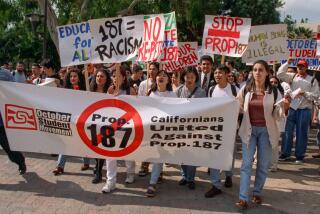The term ‘Asian’ may be overly broad but California is stuck with it

Many of California’s Hmong immigrants arrived as refugees from war and genocide and have struggled, remaining one of the poorest ethnic groups in the state. By contrast, Taiwanese immigrants typically came to California with more money and education, and they now rank among the state’s most affluent groups.
About 70% of California’s Indian Americans older than 25 hold bachelor’s degrees, but that’s true for just 10% of California’s Laotian Americans. Differences like these are what motivated legislators to propose a bill that would have asked state colleges and universities and a health agency to collect more detailed data on at least a dozen specific Asian nationalities, rather than lumping them together in a single category.
AB 176 passed unanimously in the state Senate and drew just one dissenting vote in the Assembly.
Yet earlier this month, Gov. Jerry Brown vetoed it, expressing concern about “an ever growing desire to stratify.”
“Dividing people into ethnic or other sub categories may yield more information, but not necessarily greater wisdom about what actions should follow,” Brown wrote in his veto message. “To focus just on ethnic identity may not be enough.”
But Asian leaders and activists say stratification is necessary to reflect the diversity of California’s booming 5.6-million-strong Asian and Pacific Islander population, the largest of any state. They have long criticized the label “Asian” as absurdly broad, and said more nuanced data would have helped administrators and activists create programs to target struggling students. Beyond that, they saw the bill as part of a long fight against the “model-minority myth” — the assumption that all Asian Americans are affluent, well-educated, and high achieving. And Brown’s veto deprived them of a tool, they said.
“I think he is ignoring the … reality of how diverse our nation, and in particular, California, is becoming,” said Quyen Dinh, executive director of the Southeast Asia Resource Action Center. The stratification Brown refers to “is our identity,” Dinh said.
Barbara O’Connor, the director of the Institute for the Study of Politics and Media at Cal State Sacramento and a former Brown appointee, thinks that Brown’s veto stemmed from a concern about fragmenting society, and specifically Asian political power. Being lumped together in one group may conceal disparities in education and income among Asian populations, but it also collectively gives everyone a louder voice, O’Connor said.
“I think he really believes that minorities of all types are represented better when they’re not stratified,” O’Connor said. “Asians have more clout in Sacramento when they act as a caucus.”
AB 176, sponsored by Assemblyman Rob Bonta (D-Alameda), asked UC and Cal State universities, community colleges and the state Department of Managed Healthcare, which oversees insurance plans, to gather data on at least a dozen specific nationalities, including Bangladeshi, Cambodian, Indonesian, Laotian, Malaysian, Pakistani, Sri Lankan and Taiwanese.
Bonta said he was blindsided by Brown’s veto and confused by the language of his letter. He and several members of the Asian and Pacific Islander legislative caucus staged a news conference condemning Brown’s decision and committing to reintroducing the bill next year.
“I don’t know what he meant,” Bonta said. “There’s an existing reality of stratification based on disparate outcomes, and this bill was trying to uncover and identify those problems.”
The veto was particularly surprising because AB 176 was modeled after a similar 2011 piece of legislation that Brown signed, Bonta said. AB 1088 required the Department of Industrial Relations, a labor agency, and the Department of Fair Employment and Housing to begin collecting data about the same groups of people.
“It shows that at one point at least, the governor thought this was important,” Bonta said.
Brown’s office declined multiple requests from The Times for comment and clarification.
Asian Americans as a whole are the most educated and high-earning demographic in the country, scoring higher on standardized tests and gaining acceptance to elite universities and colleges at disproportionate rates.
But research also shows that that success is a generalization, said Karthick Ramakrishnan, a UC Riverside public policy professor who serves on the state’s Commission on Asian and Pacific Islander American Affairs. California has the largest and most diverse Asian population of any state, with at least two dozen Asian ethnic groups, Ramakrishnan said.
“Just knowing someone is Asian tells you very little about what they’ve gone through,” Ramakrishnan said.
The way California categorizes people can determine whether state, federal and private institutions direct money to them. Scholarships and fellowships for poor and underrepresented minorities don’t always include Hmongs, or Cambodians or Filipinos, for example, Ramakrishnan said.
Savenaca Gasaiwai, a Fijian American senior at UC Irvine, has followed AB 176 closely and was disappointed when Brown vetoed it.
“I’m kind of tired of this whole lumping us together in this monolithic whole and conflating all the data,” Gasaiwai said.
Growing up, his ethnicity was most recognizable as the brand of a luxury bottled water: Fiji. His teachers often assumed he was Puerto Rican or black, and he said he has even been mistaken for a dark-skinned Japanese person, thanks to confusion about the name of a mountain in Japan — Mt. Fuji.
When he got to college, people asked him if he had gotten in on an athletic scholarship, though he considers himself academically oriented. He didn’t quite fit into Irvine’s Asian American student groups, and there were few specific programs and clubs for Pacific Islanders. He started to question whether he belonged anywhere, Gasaiwai said.
Bonta said that if the state required colleges to regularly gather and report more thoroughly on people’s ethnic makeup it would help students who don’t fit the mold of the high-achieving Asian American.
Bonta, the state’s first Filipino American legislator, recalls being a kid struggling to figure out which box to check on standardized test forms. As a political chair of a Filipino student group at Yale University, he requested information on rates of retention and graduation for Filipino students and found that the university didn’t have it.
“When you use the monolithic Asian category, you render invisible the experiences of each specific population,” Bonta said.
Thear Chum, a Cambodian American and former refugee, says Brown doesn’t understand what it’s like in his community. As a case manager at the Vietnamese Youth Development Center in San Francisco, he believes that AB 176 would not only have helped his organization get more money, but might have helped change teachers’ approach to their students.
The model-minority myth “puts this expectation on us,” Chum said. “If I’m not good at math, but teachers don’t think I’m struggling, how do I get help?”
Twitter: @frankshyong
ALSO
Black Lives Matter’s disruptive tactics test L.A. leaders
L.A. County denies aid to mentally ill homeless people, advocates say
Bob Barker trips on L.A. sidewalk and injures his head
More to Read
Sign up for Essential California
The most important California stories and recommendations in your inbox every morning.
You may occasionally receive promotional content from the Los Angeles Times.











